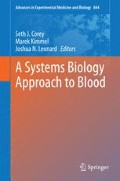Abstract
A systems approach to blood diseases can help make essential contributions to our ability to diagnose, treat, and perhaps even prevent common diseases in humans. Using blood as a window, one can study health and disease through this unique tool box with reactive biological fluids that mirrors the prevailing hemodynamics of the vessel walls and the various blood cell types. Many blood diseases, rare and common, can and have been exploited using systems biology approaches with successful results and therefore ideal models for systems medicine. More importantly, hematopoiesis offers one of the best studied systems with insight into stem cell biology, cellular interaction, development; linage programming and reprogramming that are influenced every day by the most mature and understood regulatory networks.
The views expressed by PQ in this chapter are personal and do not necessarily represent those of the US government.
Access this chapter
Tax calculation will be finalised at checkout
Purchases are for personal use only
References
Kim SI, Bresnick EH. Transcriptional control of erythropoiesis: emerging mechanisms and principles. Oncogene. 2007;26:6777–94.
Rothenberg EV. Negotiation of the T lineage fate decision by transcription-factor interplay and microenvironmental signals. Immunity. 2007;26:690–702.
Rossi DJ, Bryder D, Zahn JM, Ahlenius H, Sonu R, Wagers AJ, Weissman IL. Cell intrinsic alterations underlie hematopoietic stem cell aging. Proc Natl Acad Sci U S A. 2005;102:9194–9.
Rossant J. Stem cells: the magic brew. Nature. 2007;448:260–2.
Davidson EH, McClay DR, Hood L. Regulatory gene networks and the properties of the developmental process. Proc Natl Acad Sci U S A. 2003;100:1475
Kee Y, D’Andrea AD. Molecular pathogenesis and clinical management of Fanconi anemia. J Clin Invest. 2012;122(11):3799–806.
Tategu M, Arauchi T, Tanaka R, et al. Systems biology-based identification of crosstalk between E2F transcription factors and the Fanconi anemia pathway. Gene Regul Syst Bio. 2007;1:1–8.
Garaycoechea JI, Crossan GP, Langevin F, Daly M, Arends MJ, Patel KJ. Genotoxic consequences of endogenous aldehydes on mouse hematopoietic stem cell function. Nature. 2012;489:571–5.
Draptchinskaia N, Gustavsson P, Andersson B, et al. The gene encoding ribosomal protein S19 is mutated in Diamond-Blackfan anemia. Nat Genet. 1999;21:169–75.
Narla A, Vlachos A, Nathan DG. Diamond Blackfan anemia treatment: past, present, and future. Semin Hematol. 2011;48(2):117–23.
Ball S. Diamond Blackfan anemia. Hematology Am Soc Hematol Educ Program. 2011;2011:487.
Sankaran VG, Ghazvinian R, Do R, Thiru P, et al. Exome sequencing identifies GATA1 mutations resulting in Diamond-Blackfan anemia. J Clin Invest. 2012;122:2439–43.
Du HY, Mason PJ, Bessler M, Wilson DB. TINF2 mutations in children with severe aplastic anemia. Pediatr Blood Cancer. 2009;52:687.
Yamaguchi H, Baerlocher GM, Lansdorp PM, Chanock SJ, Nunez O, Sloand E, et al. Mutations of the human telomerase RNA gene (TERC) in aplastic anemia and myelodysplastic syndrome. Blood. 2003;102:916–8.
Alter BP, Young NS. The bone marrow failure syndromes. In: Nathan DG, Orkin HS, editors. Hematology of infancy and childhood, vol. 1. Philadelphia: Saunders; 1998. pp. 237–335.
Kirwan M, Dokal I. Dyskeratosis congenita, stem cells and telomeres. Biochim Biophys Acta. 2009;1792:371–9.
Agarwal S, Loh YH, McLoughlin EM, Huang J, Park IH, Miller JD, et al. Telomere elongation in induced pluripotent stem cells from dyskeratosis congenita patients. Nature. 2010;464:292–6.
Hood L, Qiang T. Systems approaches to biology and disease enable translational systems medicine. Genomics Proteomics Bioinform. 2012;10(4):10181–5.
Leroy H, James RH, Michael EP, Biaoyang L. Systems biology and new technologies enable predictive and preventative medicine. Science. 2004;306:640–3.
Diamond SL. Systems biology to predict blood function. J Thromb Haemost. 2009;7:177–80.
Flamm MH, Colace TV, Chatterjee MS, Jing H, et al. Multiscale prediction of patient-specific platelet function under flow. Blood. 2012;120:190–8.
Matthew HF, Thomas VC, et al. Multiscale prediction of patient-specific platelet function under flow. Blood. 2012;120:190–8.
Giuseppe P, Bernhard ØP, Olafur ES, et al. Systems biology of stored blood cells: can it help to extend the expiration date? J Proteomics. 2012;76:163–7.
Sebastiani P, Ramoni MF, Nolan V, Baldwin CT, Steinberg MH. Genetic dissection and prognostic modeling of overt stroke in sickle cell anemia. Nat Genet. 2005;37:435–40.
Lei H, Karniadakis GE. Quantifying the rheological and hemodynamic characteristics of sickle cell anemia. Biophys J. 2012;102(2):185–94.
Sankaran VG, Menne TF, Xu J, Akie TE, et al. Human fetal hemoglobin expression is regulated by the developmental stage-specific repressor BCL11A. Science. 2008;322(5909):1839–42.
Stuart HO, Leonard IZ. Hematopoiesis: an evolving paradigm for stem cell biology. Cell. 2008;132:631–44.
Vijay GS, Stuart HO. Genome-wide association studies of hematologic phenotypes: a window into human hematopoiesis. Curr Opin Genet Dev. 2013;23:1–6.
Joseph L, Albert-Laszlo B. Systems biology and the future of medicine, Wiley Interdiscip. Rev Syst Biol Med. 2011;3(6):619–27.
Carlson B. Biotechnol Healthc. Spring. 2010;7(1):12–7.
Rothenberg EV, Zhang J, Li L. Multilayered specification of the T-cell lineage fate. Immunol Rev. 2010;238:150–68.
Georgescua C, Longabaughb WJR, Scripture-Adams DD, David-Fung ES, et al. A gene regulatory network armature for T lymphocyte specification. Proc Natl Acad Sci U S A. 2008;105:20100–105.
Hood L. Deciphering complexity: a personal view of systems biology and the coming of “Big” science. Genet Eng Biotechnol News. 2011;31:131.
Author information
Authors and Affiliations
Corresponding author
Editor information
Editors and Affiliations
Rights and permissions
Copyright information
© 2014 Springer Science+Business Media New York
About this chapter
Cite this chapter
Qasba, P. (2014). A Systems Approach to Blood Disorders. In: Corey, S., Kimmel, M., Leonard, J. (eds) A Systems Biology Approach to Blood. Advances in Experimental Medicine and Biology, vol 844. Springer, New York, NY. https://doi.org/10.1007/978-1-4939-2095-2_19
Download citation
DOI: https://doi.org/10.1007/978-1-4939-2095-2_19
Published:
Publisher Name: Springer, New York, NY
Print ISBN: 978-1-4939-2094-5
Online ISBN: 978-1-4939-2095-2
eBook Packages: Biomedical and Life SciencesBiomedical and Life Sciences (R0)

